Hue, the ancient capital, known for its poetic and serene beauty, is not only famous for its majestic tombs and ancient palaces but also for its sacred ancient pagodas imbued with historical and cultural imprints. Among them, Thien Mu Pagoda, also known as Linh Mu Pagoda, is always an attractive destination for visitors from all directions. This pagoda is not only a unique religious architectural work but also a cultural and historical symbol of Hue, a place that preserves legendary stories and witnesses the ups and downs of the country. Let’s explore the ancient, sacred beauty and profound cultural values of Thien Mu Pagoda on your Hue travel journey with “Travel Around The World”.
Introducing Thien Mu Pagoda in Hue
Prime Location by the Perfume River
Located on Ha Khe hill, in Kim Long ward, Hue city, Thien Mu Pagoda is like a precious gem bestowed by nature. The pagoda’s location is exceptionally special, situated on the left bank of the romantic Perfume River, about 5km west of Hue city center. Thanks to this location, Thien Mu Pagoda is not only a spiritual site but also a beautiful scenic spot where visitors can immerse themselves in the peaceful atmosphere and admire the charming natural scenery. From the pagoda, visitors can admire the gentle beauty of the Perfume River, watch boats drifting gently on the water, and feel the peace and tranquility of Hue.
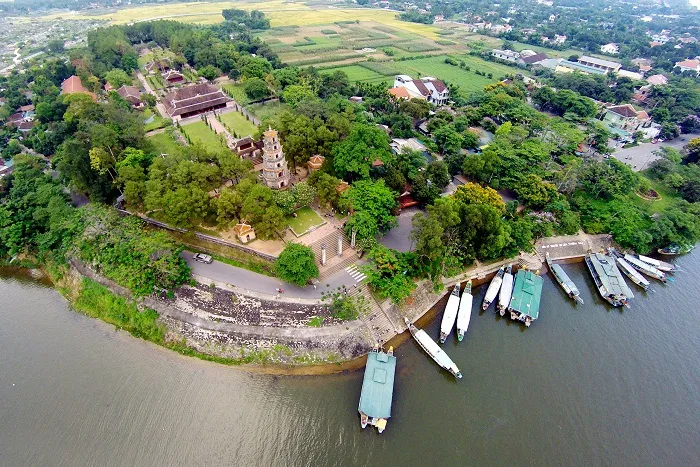
The peaceful beauty of Thien Mu Pagoda by the romantic Perfume River
Over 400 Years of History
Thien Mu Pagoda is not only famous for its architectural beauty and landscape but also for its long history and legendary stories associated with it. The pagoda was built in 1601, under the reign of Lord Nguyen Hoang, the first Nguyen Lord of Dang Trong. According to historical records, during a tour to find a location to build a foundation, Lord Nguyen Hoang encountered Ha Khe hill, shaped like a dragon turning its head to look back. Local people recounted that an old woman (Thien Mu) often appeared on the hill in dreams, prophesying that a wise lord would come to build a pagoda to gather spiritual energy and strengthen the dynasty. Lord Nguyen Hoang believed in this omen and decided to build a pagoda on the hill, naming it Thien Mu Pagoda, with the desire that the pagoda would bring prosperity and peace to the country.
Throughout more than 400 years of history, Thien Mu Pagoda has undergone many renovations, expansions, and name changes. Under King Tu Duc, the pagoda was once renamed Linh Mu Pagoda with the desire to pray for children, but later it was returned to its familiar name Thien Mu. However, the name Linh Mu is still commonly used by people today. Thien Mu Pagoda is not only a place of practice for monks and nuns but also a place that preserves many precious cultural and historical values, associated with the historical upheavals of the nation.
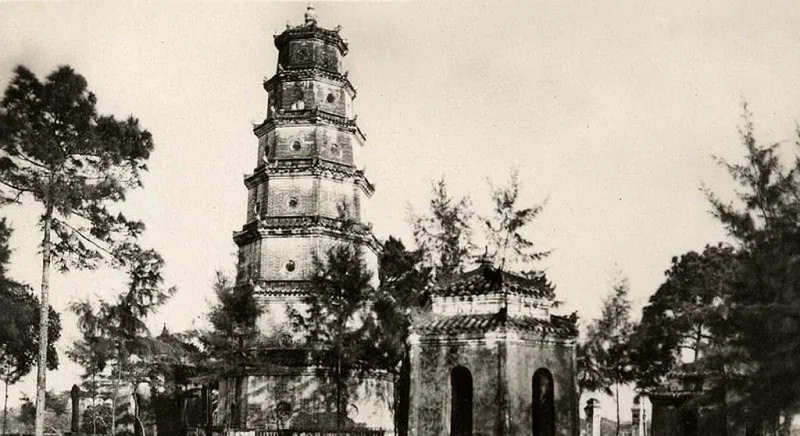
Ancient Thien Mu Pagoda in old photos
Unique Architecture
Thien Mu Pagoda is a massive Buddhist architectural complex, harmoniously blending with the surrounding natural landscape. The pagoda’s architecture is deeply imbued with Hue style, combining the majestic, ancient features of imperial architecture and the purity and simplicity of Buddhist architecture. The most prominent highlight of Thien Mu Pagoda is Phuoc Duyen Tower, an indispensable symbol when mentioning this pagoda. In addition, the pagoda also has many other architectural works such as the Tam Quan Gate, Dai Hung Hall, Quan Am Hall, Lecture Hall, Monk’s Residence, etc. Each work has its own beauty, contributing to the diversity and richness of the overall architecture of Thien Mu Pagoda. The structures in the pagoda are arranged symmetrically and harmoniously, creating a space that is both solemn and serene, suitable for religious practice and sightseeing.
Exploring the Architecture and Antiques of Thien Mu Pagoda
Majestic Tam Quan Gate
Stepping through the Tam Quan Gate, visitors feel like entering another world, separated from the noise and bustle of everyday life. The Tam Quan Gate of Thien Mu Pagoda is built in the traditional architectural style, with 2 floors, 8 roofs, and 3 entrances. The gate’s roof is tiled, with curved eaves, creating a majestic and imposing beauty. On both sides of the walkway are statues of Dharma Protectors, with imposing appearances, guarding the pagoda gate and protecting the peace of the sacred place. Through the Tam Quan Gate, visitors will admire the giant wooden sculptures, showing the talent and sophistication of ancient artisans. The Tam Quan Gate is not only the entrance to the pagoda but also a unique architectural artwork, expressing the solemnity and sacredness of Thien Mu Pagoda.
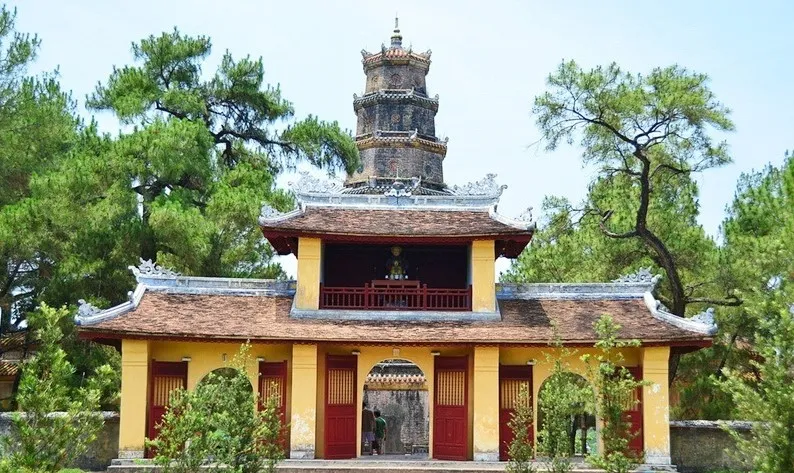
Majestic Tam Quan Gate, the entrance to the monastic realm
Phuoc Duyen Tower – The Symbol
Phuoc Duyen Tower, also known as Bat Giac Tower, is the most distinctive and famous symbol of Thien Mu Pagoda. The tower was built in 1844, under the reign of King Thieu Tri, with a height of 21 meters, consisting of 7 floors, each floor worshiping a different Buddha. The tower is built in an octagonal shape, with a graceful and harmonious architecture. Each floor of the tower has a curved roof, decorated with intricate patterns. Inside the tower, there is a spiral staircase leading to the top floor, where a gold Buddha statue was previously worshiped. Phuoc Duyen Tower is not only a religious architectural work but also a unique work of art, demonstrating the sophistication and talent of the ancients. Standing at the foot of Phuoc Duyen Tower, visitors can feel the majesty, antiquity, and timeless beauty of this architectural work.
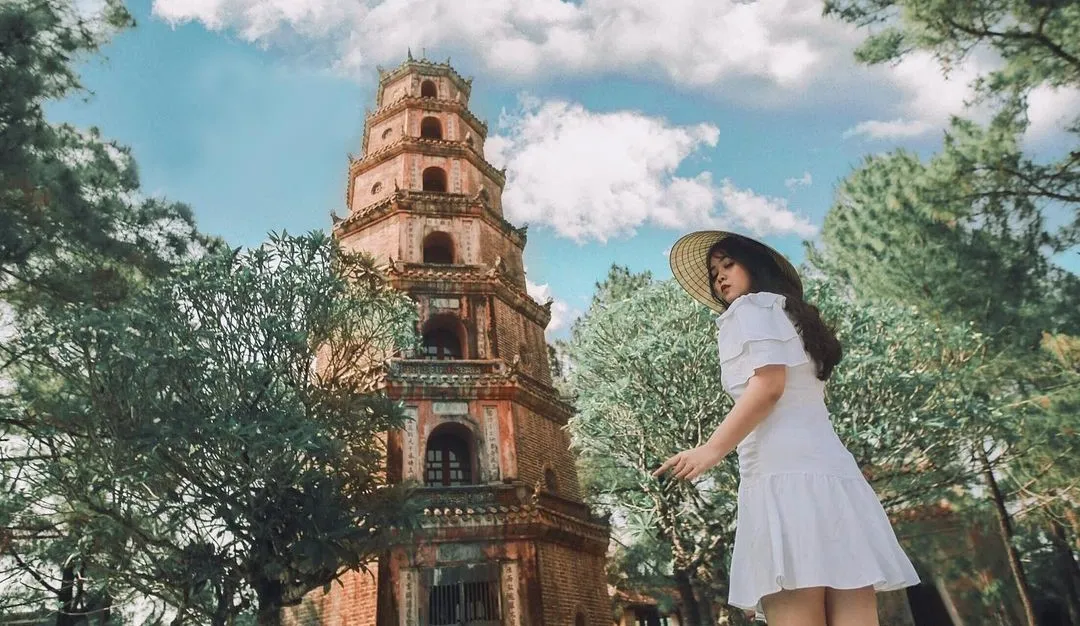
Phuoc Duyen Tower, a symbol of Thien Mu Pagoda and the dreamy Hue
Trang Nghiem Dai Hung Hall (Solemn Dai Hung Hall)
Dai Hung Hall is the main hall of Thien Mu Pagoda, where Buddha is worshiped and important religious ceremonies take place. The hall is built in the style of ” trùng thiềm điệp ốc ” architecture, with layered tiled roofs, creating a majestic and imposing beauty. The pillars and beams in the hall are made of concrete, with the outside painted to resemble wood, still retaining the ancient and traditional features. Inside the hall, statues of Maitreya Buddha and many other Buddha statues are worshiped. Above the hall hangs a horizontal lacquered board inscribed with 4 characters “Linh Thửu Cao Phong”, meaning the sacredness and nobility of Buddhist Dharma. Inside the hall, there is also a giant bronze bell, cast in 1710, with a height of 2.5 meters and a weight of over 2 tons. Dai Hung Hall is the most sacred place of Thien Mu Pagoda, where visitors can pray for peace, luck, and admire the unique architectural beauty.
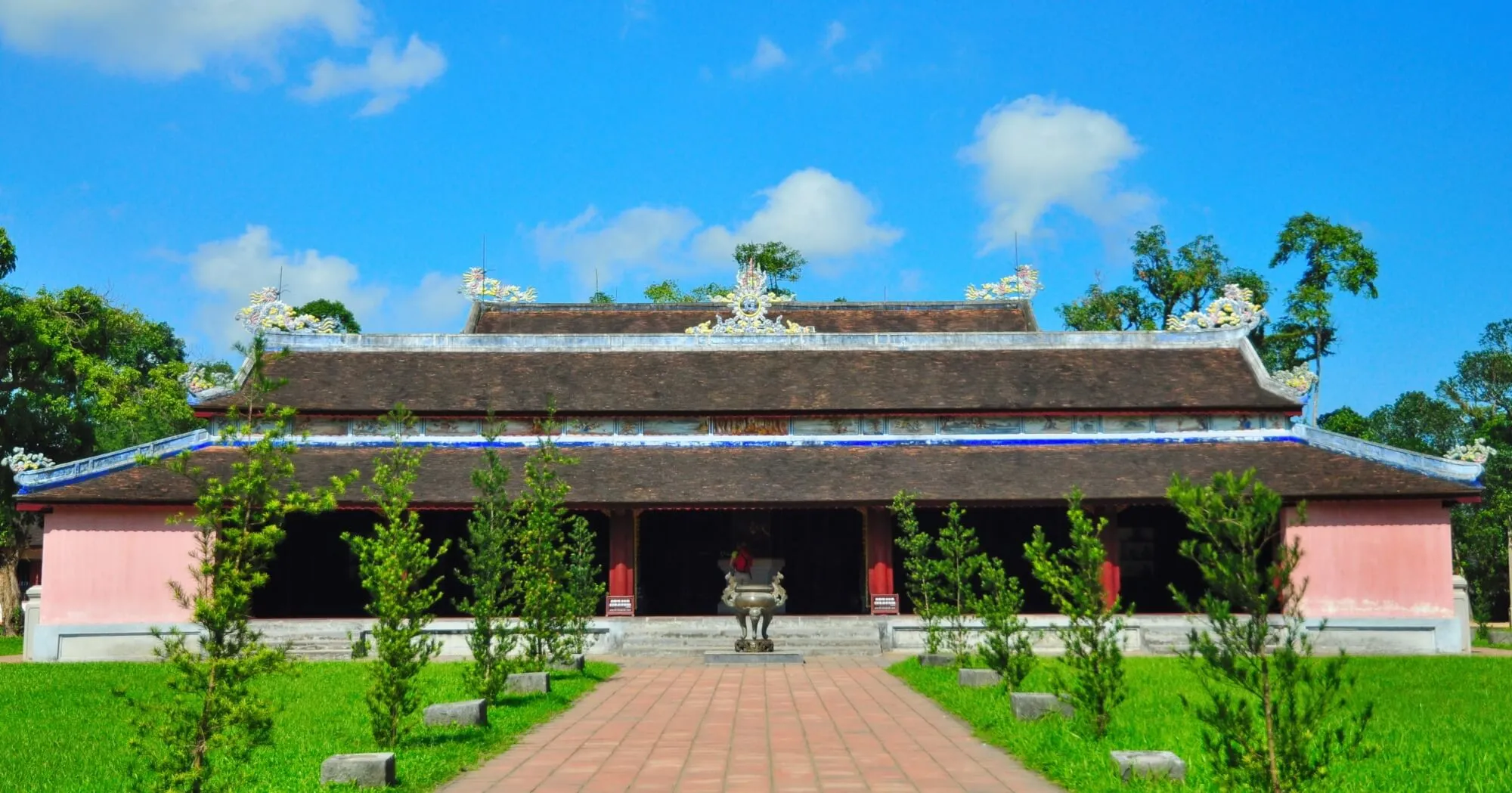
Dai Hung Hall, the solemn main hall of Thien Mu Pagoda
Garden and Other Structures
In addition to the prominent architectural works, Thien Mu Pagoda also has a large, green campus with many trees, flower gardens, and other architectural structures such as Dinh Huong Nguyen, Dien Dia Tang, Dien Quan Am, etc. The pagoda’s campus is meticulously cared for, creating a peaceful and tranquil space, very suitable for visitors to relax, stroll, and enjoy the pagoda scenery. Dinh Huong Nguyen is a place for incense offering and prayer, Dien Dia Tang worships the Earth Store Bodhisattva, and Dien Quan Am worships the Avalokiteśvara Bodhisattva. Each structure has its own meaning and beauty, contributing to enriching the architectural space of Thien Mu Pagoda.
Historical Car and Artifacts
Behind Dai Hung Hall, Thien Mu Pagoda also preserves a very special historical artifact, which is a blue Austin car, license plate DBA 577. This is the car that transported Most Venerable Thich Quang Duc from Ấn Quang Pagoda (Saigon) to the intersection of Nguyen Dinh Chieu and Le Van Duyet streets (now Cach Mang Thang Tam and Nguyen Thi Minh Khai streets) on June 11, 1963, where the monk self-immolated to protest the Ngo Dinh Diem regime’s policy of suppressing Buddhism. The car is a historical relic, reminding of a painful period of Vietnamese Buddhism and the courageous spirit of self-sacrifice for the Dharma of Most Venerable Thich Quang Duc. Thien Mu Pagoda’s preservation of this car further enhances the historical and cultural value of the pagoda.
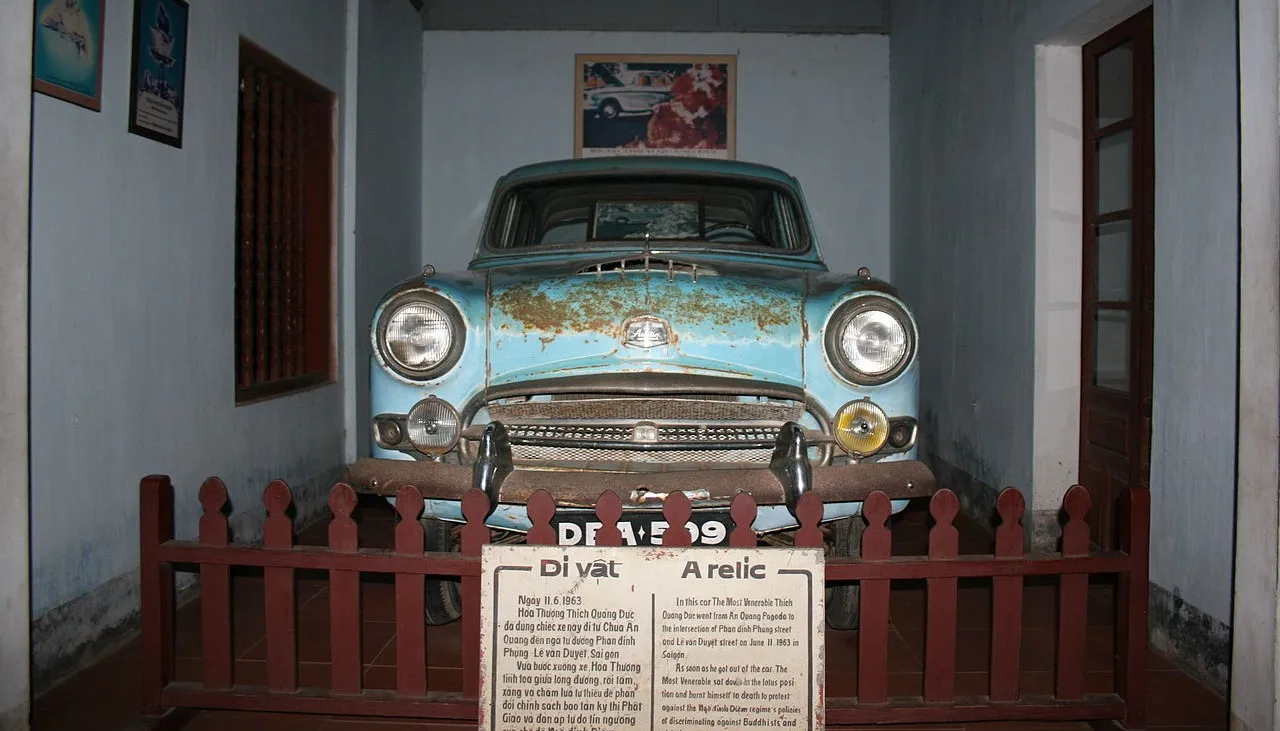
The historical car, a testament to the noble act of Most Venerable Thich Quang Duc
Spiritual Travel Experience at Thien Mu Pagoda
Ideal Time to Visit the Pagoda
Hue has four distinct seasons, each with its own beauty. However, the best time to visit Thien Mu Pagoda in Hue is in spring (from January to March) and autumn (from September to November). In spring, Hue’s weather is cool and pleasant, trees sprout buds and leaves, and the scenery is beautiful. In autumn, Hue has a gentle, romantic beauty with light rains and cool air. This is a suitable time for visitors to enjoy the pagoda scenery, enjoy the peaceful space, and participate in Buddhist festivals if any. Summer (from April to August) in Hue is quite hot and rainy, but if you want to experience the vibrant atmosphere of summer festivals in Hue, this is also an option. Winter (from December to January) in Hue is quite cold but has its own contemplative and tranquil beauty.
How to Get to Thien Mu Pagoda
Thien Mu Pagoda is located about 5km from the city center of Hue, making it quite easy and convenient to get to. Visitors can choose many different means of transportation to get to the pagoda, depending on their preferences and personal conditions:
- Motorbike, car: This is the most popular and proactive means of transportation. Visitors can rent motorbikes or self-drive cars, or take taxis or ride-hailing motorbikes. The road to Thien Mu Pagoda is quite easy to find and beautiful, visitors can both travel and enjoy the scenery.
- Cyclo: Cyclo is a typical means of transportation in Hue, very suitable for visitors to both visit the city and go to Thien Mu Pagoda. Sitting on a cyclo, visitors can slowly admire the streets of Hue and enjoy the fresh air.
- Boat on the Perfume River: This is a unique and romantic experience. Visitors can rent a boat on the Perfume River from Trang Tien wharf, both admiring the poetic Perfume River scenery and reaching Thien Mu Pagoda. Traveling by boat on the Perfume River usually takes about 2 hours, but this is a memorable experience.
- Bus: If you want to save costs, visitors can take a public bus. There are many bus routes passing by Thien Mu Pagoda, visitors can find information about bus routes at the bus station or on mobile applications.
Notes When Visiting
When visiting Thien Mu Pagoda, visitors should note the following to make the visit complete and meaningful:
- Dress code: When coming to the pagoda, visitors should dress politely and discreetly, avoiding wearing revealing or offensive clothing.
- Behavior and attitude: In the pagoda grounds, visitors should maintain a solemn and respectful attitude, not speak loudly, laugh, or make noise, affecting the peaceful space of the pagoda. Do not arbitrarily touch artifacts or Buddha statues in the pagoda.
- Maintain hygiene: Visitors should maintain general hygiene, not litter indiscriminately within the pagoda grounds.
- Visiting hours: Thien Mu Pagoda is open to visitors from morning to evening. Visitors should arrange a reasonable visiting time to be able to explore all the beauty of the pagoda.
Conclusion: Thien Mu Pagoda – A Must-Visit Destination in Hue
Thien Mu Pagoda is not only a sacred ancient pagoda but also a cultural and historical symbol of Hue. With its prime location by the Perfume River, unique architecture, long history, and profound cultural values, Thien Mu Pagoda deserves to be a must-visit destination in the journey to explore the dreamy Hue. Come to Thien Mu Pagoda to feel the peace and tranquility, explore the ancient beauty, and learn about the legendary and historical stories associated with this pagoda. Surely, a visit to Thien Mu Pagoda will bring you meaningful spiritual experiences and unforgettable memories of Hue.